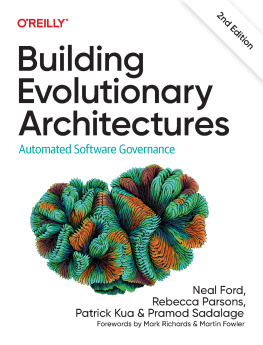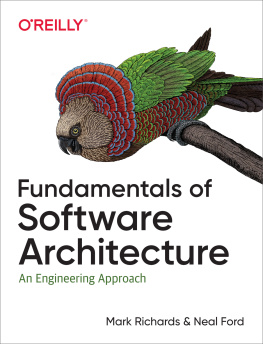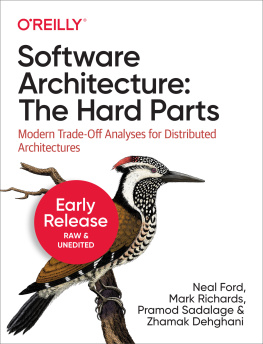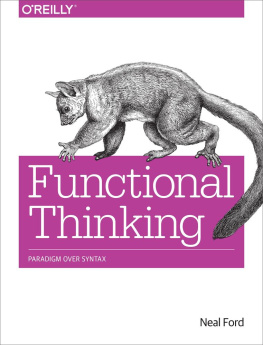Neal Ford - Building Evolutionary Architectures, 2nd Edition
Here you can read online Neal Ford - Building Evolutionary Architectures, 2nd Edition full text of the book (entire story) in english for free. Download pdf and epub, get meaning, cover and reviews about this ebook. year: 2022, publisher: OReilly Media, Inc., genre: Computer. Description of the work, (preface) as well as reviews are available. Best literature library LitArk.com created for fans of good reading and offers a wide selection of genres:
Romance novel
Science fiction
Adventure
Detective
Science
History
Home and family
Prose
Art
Politics
Computer
Non-fiction
Religion
Business
Children
Humor
Choose a favorite category and find really read worthwhile books. Enjoy immersion in the world of imagination, feel the emotions of the characters or learn something new for yourself, make an fascinating discovery.
- Book:Building Evolutionary Architectures, 2nd Edition
- Author:
- Publisher:OReilly Media, Inc.
- Genre:
- Year:2022
- Rating:4 / 5
- Favourites:Add to favourites
- Your mark:
- 80
- 1
- 2
- 3
- 4
- 5
Building Evolutionary Architectures, 2nd Edition: summary, description and annotation
We offer to read an annotation, description, summary or preface (depends on what the author of the book "Building Evolutionary Architectures, 2nd Edition" wrote himself). If you haven't found the necessary information about the book — write in the comments, we will try to find it.
Neal Ford: author's other books
Who wrote Building Evolutionary Architectures, 2nd Edition? Find out the surname, the name of the author of the book and a list of all author's works by series.
Building Evolutionary Architectures, 2nd Edition — read online for free the complete book (whole text) full work
Below is the text of the book, divided by pages. System saving the place of the last page read, allows you to conveniently read the book "Building Evolutionary Architectures, 2nd Edition" online for free, without having to search again every time where you left off. Put a bookmark, and you can go to the page where you finished reading at any time.
Font size:
Interval:
Bookmark:

by Neal Ford , Rebecca Parsons , Patrick Kua , and Pramod Sadalage
Copyright 2023 Neal Ford, Rebecca Parsons, Patrick Kua, and Pramod Sadalage. All rights reserved.
Printed in the United States of America.
Published by OReilly Media, Inc. , 1005 Gravenstein Highway North, Sebastopol, CA 95472.
OReilly books may be purchased for educational, business, or sales promotional use. Online editions are also available for most titles (http://oreilly.com). For more information, contact our corporate/institutional sales department: 800-998-9938 or corporate@oreilly.com.
- Acquisitions Editor: Melissa Duffield
- Development Editor: Virginia Wilson
- Production Editor: Christopher Faucher
- Copyeditor: Audrey Doyle
- Proofreader: Piper Editorial Consulting, LLC
- Indexer: WordCo Indexing Services, Inc.
- Interior Designer: David Futato
- Cover Designer: Karen Montgomery
- Illustrator: OReilly Media, Inc.
- October 2017: First Edition
- December 2022: Second Edition
- 2022-11-22: First Release
See http://oreilly.com/catalog/errata.csp?isbn=9781492097549 for release details.
The OReilly logo is a registered trademark of OReilly Media, Inc. Building Evolutionary Architectures, the cover image, and related trade dress are trademarks of OReilly Media, Inc.
The views expressed in this work are those of the authors and do not represent the publishers views. While the publisher and the authors have used good faith efforts to ensure that the information and instructions contained in this work are accurate, the publisher and the authors disclaim all responsibility for errors or omissions, including without limitation responsibility for damages resulting from the use of or reliance on this work. Use of the information and instructions contained in this work is at your own risk. If any code samples or other technology this work contains or describes is subject to open source licenses or the intellectual property rights of others, it is your responsibility to ensure that your use thereof complies with such licenses and/or rights.
978-1-492-09754-9
[LSI]
For a long time, the software industry followed the notion that architecture was something that ought to be developed and completed before writing the first line of code. Inspired by the construction industry, it was felt that the sign of a successful software architecture was something that didnt need to change during development, often a reaction to the high costs of scrap and rework that would occur due to a re-architecture event.
This vision of architecture was rudely challenged by the rise of agile software methods. The preplanned architecture approach was founded on the notion that requirements should also be fixed before coding began, leading to a phased (or waterfall) approach where requirements were followed by architecture which itself was followed by construction (programming). The agile world, however, challenged the very notion of fixed requirements, observing that regular changes in requirements were a business necessity in the modern world and providing project planning techniques to embrace controlled change.
In this new agile world, many people questioned the role of architecture. And certainly the preplanned architecture vision couldnt fit in with modern dynamism. But there is another approach to architecture, one that embraces change in the agile manner. In this perspective, architecture is a constant effort, one that works closely with programming so that architecture can react both to changing requirements and to feedback from programming. Weve come to call this evolutionary architecture, to highlight that while the changes are unpredictable, the architecture can still move in a good direction.
At Thoughtworks, weve been immersed in this architectural worldview. Rebecca led many of our most important projects in the early years of this millennium and developed our technical leadership as our CTO. Neal has been a careful observer of our work, synthesizing and conveying the lessons weve learned. Pat has combined his project work with developing our technical leads. Weve always felt that architecture is vitally important and cant be left to idle chance. Weve made mistakes, but weve learned from them, growing a better understanding of how to build a codebase that can respond gracefully to the many changes in its purpose.
The heart of doing evolutionary architecture is to make small changes and put in feedback loops that allow everyone to learn from how the system is developing. The rise of Continuous Delivery has been a crucial enabling factor in making evolutionary architecture practical. The authorial trio use the notion of fitness functions to monitor the state of the architecture. They explore different styles of evolvability for architecture and emphasize the issues around long-lived dataoften a topic that gets neglected. Conways Law towers over much of the discussion, as it should.
While Im sure we have much to learn about doing software architecture in an evolutionary style, this book marks an essential road map for the current state of understanding. As more people are realizing the central role of software systems in our 21st-century human world, knowing how best to respond to change while keeping on your feet will be an essential skill for any software leader.
Martin Fowler
martinfowler.com
September 2017
A metaphor attempts to describe similarities between two unrelated things in order to clarify their essential elements. A good example of this is with software architecture. We commonly attempt to describe software architecture by comparing it to the structure of a building. The things that make up the structure of a buildingits outer walls, inner walls, roof, room size, number of floors, even the location of the buildingall relate to structural elements of software architecturedatabases, services, communication protocols, interfaces, deployment location (cloud, on-premises), and so on. The old view is that in both cases these are things that, once in place, are very hard to change later. And thats exactly where the building metaphor breaks down.
Today, the building metaphor for software architecture is no longer a valid one. While its still useful to explain what software architecture is to a nontechnical person in terms of comparing the structure of a system, software architecture must be malleable enough to change quickly, which is very different from a physical building. Why must software architecture be so malleable? Because businesses are in a constant state of rapid change, undergoing mergers, acquisitions, new business lines, cost-cutting measures, organizational structures, and so on. However, so is technology, with new frameworks, technical environments, platforms, and products. To properly align with the business and technology environment, software architecture must change as well, and at the same rapid pace. A good example is a major acquisition by a large company. Aside from the myriad business concerns and changes, the software architectures supporting the major business applications must be able to scale to meet the additional customer base and must be both adaptable and extensible to accommodate new business functionality and practices.
Many companies already know this but struggle with one thing: how do you make software architecture malleable enough to withstand a fast rate of business and technology change? The answers are found in this book you are about to read. This second edition builds on the concepts of guided and incremental change introduced in the first edition to provide you with the latest techniques, knowledge, and tips on fitness functions, automated architectural governance, and evolutionary data to make sure your software architectures are agile enough to keep up with the constant change we are all experiencing today.
Font size:
Interval:
Bookmark:
Similar books «Building Evolutionary Architectures, 2nd Edition»
Look at similar books to Building Evolutionary Architectures, 2nd Edition. We have selected literature similar in name and meaning in the hope of providing readers with more options to find new, interesting, not yet read works.
Discussion, reviews of the book Building Evolutionary Architectures, 2nd Edition and just readers' own opinions. Leave your comments, write what you think about the work, its meaning or the main characters. Specify what exactly you liked and what you didn't like, and why you think so.












